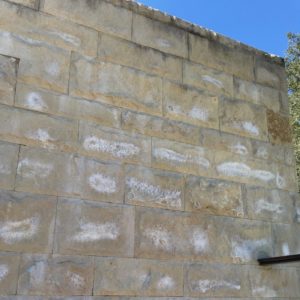Efflorescence is a common problem that affects stone, concrete and other types of masonry surfaces. To learn more about what causes efflorescence and what can be done about it, read the following guest post by Steve Spratt, president of HPS Palo Alto, Inc.

Efflorescence is a common problem that affects stone, concrete and other types of masonry surfaces. Photo: HPS Palo Alto, Inc. ©2019
If you’ve noticed white, powdery blotches on a stone, concrete, or tile surface in or around your home, it’s likely due to the phenomenon known as efflorescence. Efflorescence is caused when moisture is drawn into a masonry material via a process known as capillary action—the same process that allows tree roots to transfer water from the soil up to the leaves. As moisture is drawn through the masonry material, it becomes saturated with minerals and salt. When the moisture finally reaches the outer surface of the material, it evaporates, leaving the minerals and salt behind. This is what creates the chalky deposits that are often found on stone, concrete and tile surfaces.
The tricky thing about efflorescence is it can occur even where there are no obvious signs of moisture. Worse still, once efflorescence has taken effect, it’s very difficult to correct. You can remove it by scrubbing with a stiff brush and muriatic acid, but unless the moisture is dealt with at its root, the condition will almost inevitably return. In rare cases, the moisture will evaporate on its own, but usually, it needs to be eliminated so the masonry can dry.
Naturally, the best way to avoid efflorescence is to prevent it from happening in the first place. One smart step is placing moisture barriers directly beneath any concrete or mortar base material. You can also make a stone, concrete or tile installation less prone to efflorescence by using materials with low salt and mineral content, as well as reducing the amount of water used in concrete or mortar mixes and allowing them to thoroughly dry.
Another helpful step is incorporating proper drainage measures during construction. For exterior walls, drainage space and weep holes must be in place to allow water that enters the interior or backside to escape through the bottom. Additionally, waterproof flashing or cap material should be installed along the top of any exposed walls. These proactive measures will go a long way toward preventing efflorescence.
